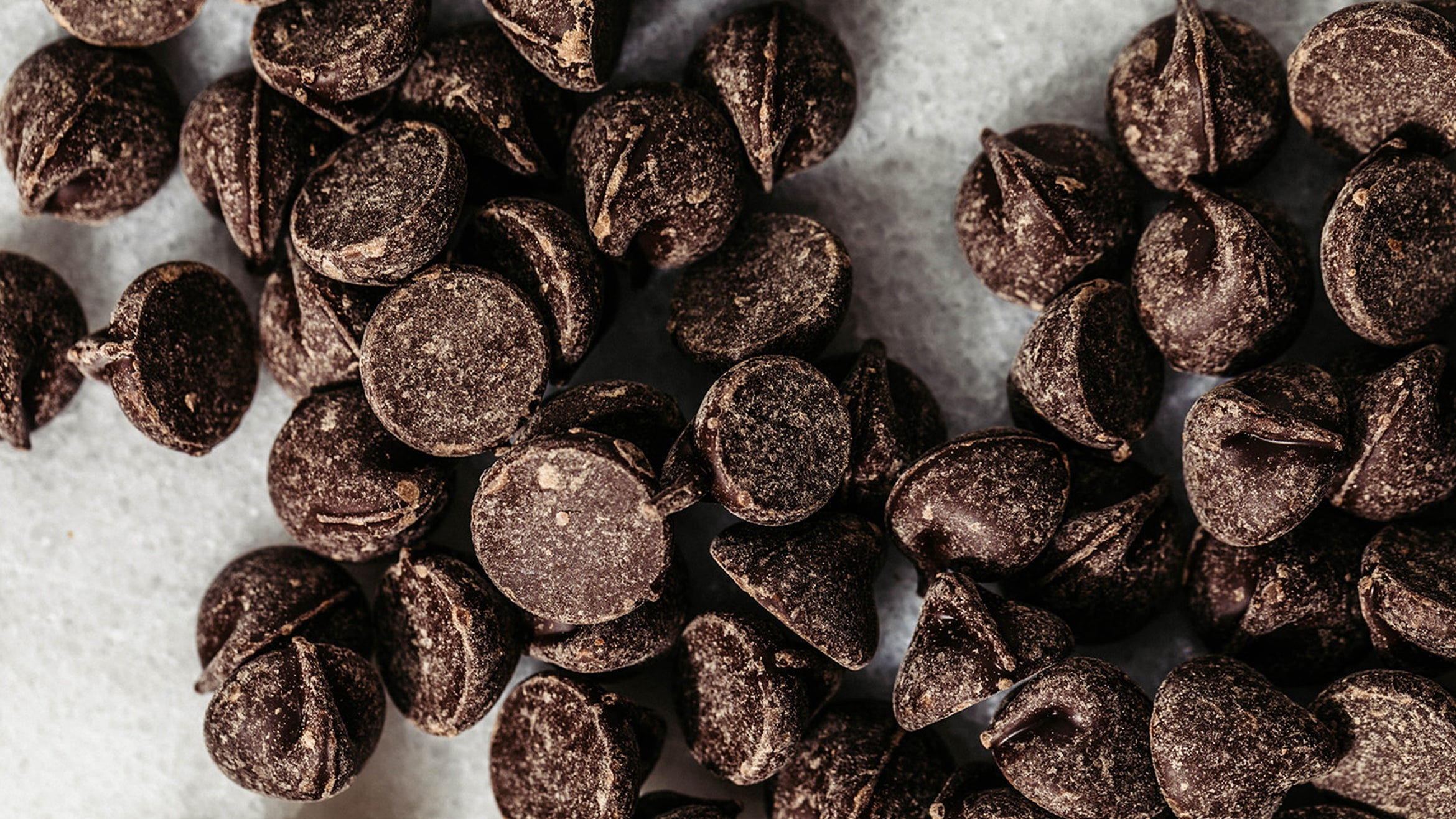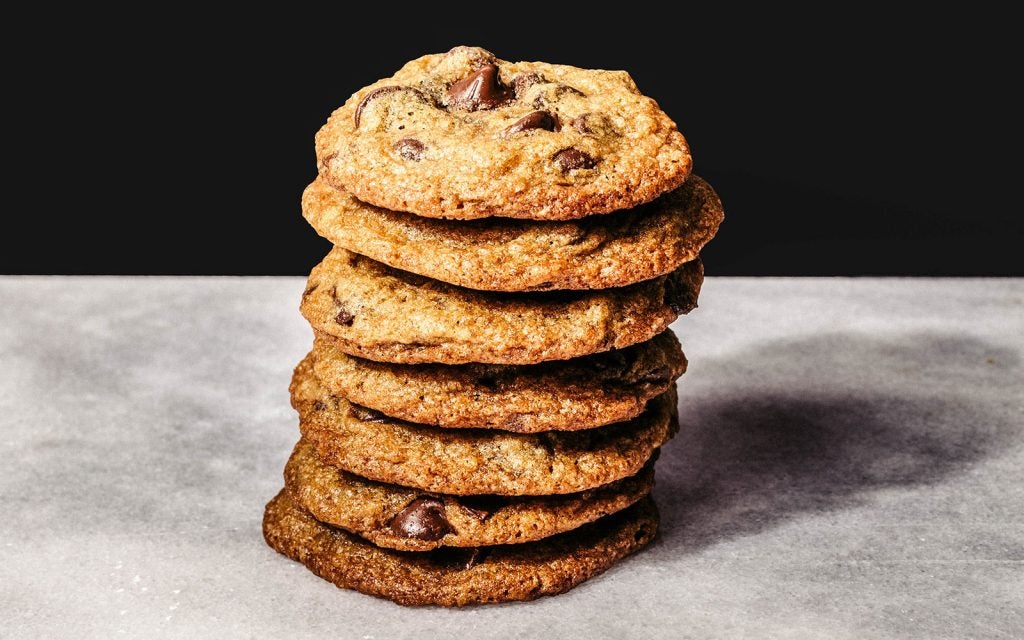If you bought a baking book recently that includes a recipe for chocolate chip cookies, chances are the author has intentionally omitted the eponymous chips. Not a single Toll House or Ghirardelli bag in sight. What in the heck is going on?
In the past few years, there has been a growing chorus of baking bloggers and pastry pontificators imploring home bakers to turn their backs on bagged chocolate chips in favor of chopping up bars of high-quality, even artisanal, chocolate for their cookies. Take this minor snark from The Artful Baker by Cenk Sönmezsoy: “If I see chocolate chips among the ingredients, I keep flipping the pages in hopes of finding a different recipe through which I can connect with the author, but deep down I know there is very little chance for us to become close friends.”
In her book, BraveTart, Serious Eats’ Stella Parks claims that the original chocolate chip cookies—those that she argues predate Ruth Wakefield’s 1938 Toll House recipe—contained “shards and shavings produced by chopped chocolate.” Parks’s own cookie recipe, accordingly, calls for “roughly chopped mixed dark, milk and/or white chocolate (not chips).” In The Good Book of Southern Baking, one of 2020’s most acclaimed releases, pastry chef Kelly Fields explains her problem with chocolate chips: “Mass-produced chocolate chips are made to hold their shape (not melt) in the oven. That processing directly changes the flavor and mouthfeel of the chocolate.” Hummingbird High blogger Michelle Lopez comes right out with it in her book, Weeknight Baking: “To make really good chocolate chip cookies, you need really good, high-quality chocolate. And real talk: Chocolate chips don’t qualify.”
And real talk: chopping chocolate sucks.
Based on statements like these, home bakers might well think that the chocolate chip of their childhood is an inferior, mass-produced product that will ruin their cookies. Are we now required to chop up bars of artisanal chocolate every time we feel like baking a batch of cookies? And real talk: chopping chocolate sucks. But aside from the convenience of the chip—which is very real for any home baker looking for fresh cookies in under an hour—the negativity toward chocolate chips overlooks the structural role they play in the cookie we all know and love. In other words, chocolate chips’ ability to hold their shape in the heat of the oven is a feature, not a bug.
It is true that chocolate chips are manufactured differently than chocolate bars, but that’s not necessarily a shortcoming. With chocolate bars, “oftentimes you’re adding cocoa butter to assist with the meltability,” explains Amy Guittard of the Guittard Chocolate Company. Chocolate chips, by contrast, contain approximately the amount of cocoa butter that comes naturally from pressing cocoa nibs. “Chocolate chips do melt, but they hold their shape better than chocolate bars or wafers because chips have less cocoa butter,” says Guittard.

This lower percentage of cocoa butter—often around 45 or 50 percent—is one of the reasons chocolate chips have a bad reputation. Because chocolate chips have less cocoa butter, they tend to have more sugar and sometimes added ingredients such as milk fat, which is cheaper than cocoa butter. (Chocolate educator Estelle Tracy, who is French, points out that, in Europe, cocoa butter is the only fat permitted in a product labeled “chocolate.” Not so in the United States.) Hence, many popular grocery store brands of chocolate chips can be overly sweet and coarse or grainy in texture.
But the good news is that the ingredients available to home bakers are always expanding. Today, the typical supermarket baking aisle offers many different brands of chocolate chips, from classics like Nestlé Toll House and Hershey’s to higher-end options such as Ghirardelli and Guittard. And it’s becoming increasingly common for chocolate chip brands to offer a variety of cacao percentages, giving consumers the chance to choose their own adventure when it comes to balancing sweetness with bitterness. For home bakers with a slightly higher budget, there are even so-called “bean-to-bar” chocolate makers, such as Éclat Chocolate in Pennsylvania and North Carolina’s French Broad Chocolate, creating their own chocolate chips that can be ordered online.
Chocolate chips’ ability to hold their shape in the heat of the oven is a feature, not a bug.
With so many options, lower-quality chips are easy to avoid. Beyond the cacao percentage (anything above 60 percent is good), another thing to look for when shopping for chocolate chips is the first ingredient listed. Is it sugar, or is it chocolate? A chip with sugar as its first ingredient will be sweeter and less chocolaty. Similarly, avoid brands that contain milk solids (unless you’re specifically shopping for a milk chocolate chip), which are present simply to keep the chocolate firm.
As for chocolate chips holding their shape, that’s what we want them to do. A cookie made with chips will maintain a clear distinction between dough and chocolate. “You expect to bite into that morsel of slightly melty chocolate,” says Susan Palmer, owner of Little Red Kitchen Bake Shop in Brooklyn, who uses chips in her cookies. “If you’re making a chocolate chip cookie with chocolate chips, those chips are going to provide structure to the cookie,” points out Guittard. Chocolate chips also lend predictability. “Using chips will make your cookie more regular, with almost the same bite every time,” explains executive pastry chef Jean-Louis Berthet of New York’s Maman bakery. “It allows me to know in advance how my cookie will be, and because of that, I’m able to play on different flavors or use different ingredients like nuts.”

Eschewing chocolate chips and the structure they provide results in a flatter cookie that photographs better, which may explain why uneven specks and large craters of hand-chopped chocolate have taken oven Instagram. And there are, admittedly, people who prefer the taste of these flakes and puddles of chocolate distributed throughout the cookie.
If you want to avoid the messy process of chopping but you still want cookies with melty puddles, both Guittard and Palmer suggest using wafers or féves, which are small enough to add directly to your cookie dough but have more cocoa butter than chips. Palmer actually includes both chips and féves in her cookie for a mix of textures and chocolates with different percentages of cocoa butter.
This is also an instance when being a little lazier in the kitchen might save you money. A chocolate chip cookie “is meant to be an inexpensive home baking project,” points out Palmer. Fields’s recipe for her bakery’s popular chocolate chip cookie contains three different kinds of hand-chopped chocolate—totaling a full pound—which could easily set you back $30 if you’re buying individual bars. By contrast, an 11.5-ounce bag of Guittard chocolate chips, such as the Extra Dark Chocolate with 63 percent cacao, retails for less than $5. Even the Éclat Chocolate bean-to-bar chips with 70 percent cocoa mass retail for $18 a pound. The math makes sense.
Ultimately, home bakers should balance all of these factors—cost, convenience, and, most important, how they want their cookies to turn out—when deciding what form of chocolate to use. But no one should feel any shame about reaching for a bag of chocolate chips, despite what the baking elites claim. “There is no such thing as the perfect chocolate chip cookie,” says baking blogger Irvin Lin. “Only the perfect chocolate chip cookie for you.”